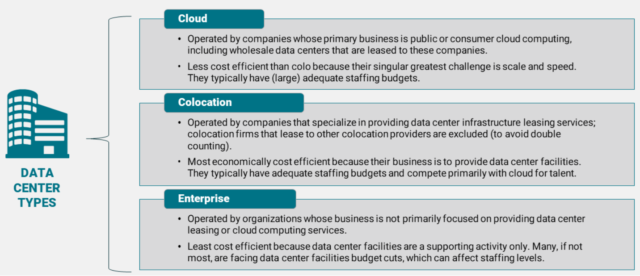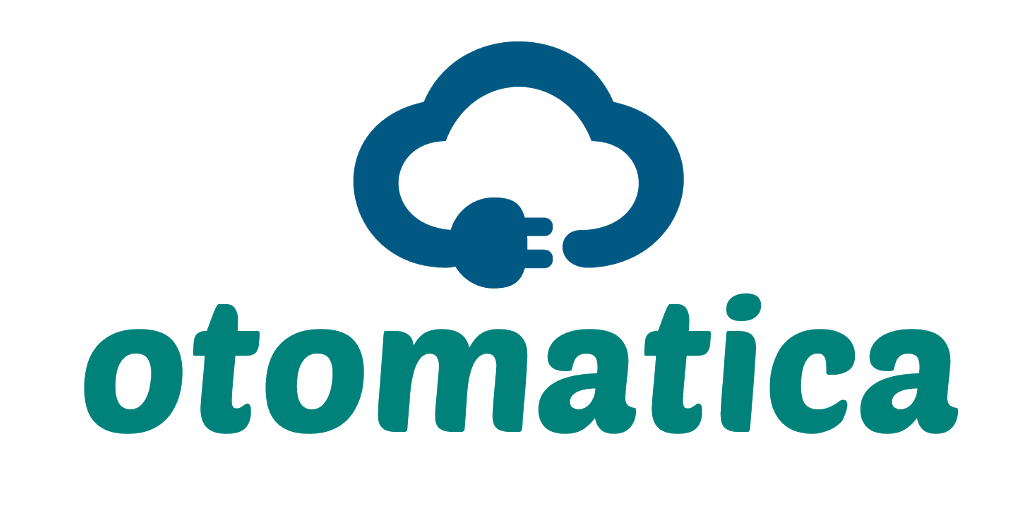What are Data Center Service Types?
Generally, data centers can be categorized into three types according to the service they provide. Enterprise, Colocation, and Cloud Computing are different services provided in data center facilities. There are facilities that host all three services together, as well as data centers those focus specifically on a single service.
The operation of the data center facility and its physical infrastructure is responsible for maintaining these services with high business continuity, reliability and performance. A disruption or interruption in this layer of physical infrastructure can cost major damages, up to loss of internal or external customer reputation. For Cloud and Hosting Service providers, success depends on external customers’ trust in the service and the fulfillment of the responsibility they maintain.

The term “cloud services” refers to a wide range of services delivered on demand to companies and customers over the internet. These services are designed to provide easy, affordable access to applications and resources, without the need for internal infrastructure or hardware. Since the cloud computing provider is responsible for the business continuity and quality of these services, it is also obliged to do all the risk management in the background. The corporation that outsources cloud services enforces its own criteria on both internet connection reliability and the cloud computing provider with the “Service Level Agreement”.
“Service Level Agreement” Is Not Sufficient for Colocation Services
Colocation services (also known as “colo”) offer a secure environment for hardware and access to network connectivity that enables reaching customers worldwide. Typically, a colocation service provides the building, cooling, power, bandwidth, and physical security while the customer provides servers. The corporation, which uses hosting services, focuses on reaching its customers quickly and reliably close enough in the regions where it is active. Therefore, it does not receive services from a single hosting facility, but from multiple facilities.
While the giant cloud providers prefer to remain limited on the edge, most of the cloud providers choose to benefit large or regional colocation services from 3rd party in order to extend their market. The growth of the cloud sector is also triggering the increase of hosting services.
To ensure the sustainable operation, the physical infrastructure of the hosting services is subject to continuous changes of states in the field. For example, planned maintenance operation sequences requires each equipment’s isolating and recommissioning activities hundreds of times each year. Risk management for zero downtime requires of the coordinated cooperation of the hosting service provider and the hosting service client. Therefore, in hosting services, the “Service Level Agreement” based on the one-sided liability perspective becomes insufficient.
With virtualization, clustering or cloud technologies, capacity utilization has become unpredictable. The reflection of this uncertainty on the critical power and cooling capacity of the infrastructure further increases the unpredictability. Therefore, site change management, capacity management, load management, white space cooling management require cooperation of both parties. There is a great risk when the hosting services customer proceeds IT-based operations blindly, without concurrently monitoring the impact on the physical infrastructure. When a problem arises in this context, the “Service Level Agreement” is not enough to manage the risk, but it becomes a reference to look for evidence of the failure. Traditionally, the provider in weaker position is declared as the unaccountable one without understanding whether he is at fault or a victim.
“Operation Level Agreement” is generally used for the coordination of internal support groups. According to the ‘Operational Level Agreement’, each support group has certain responsibilities towards the other group. It will not be possible to secure end-to-end uptime within this framework for the organization that uses hosting services from external sources and manages quality with the “Service Level Agreement”. Above this level, one way is for the internal team managing infrastructure operation to be accountable to IT services under the “Operation Level Agreement”. The goal is to provide a framework that is manageable and where mutual coordination of stakeholders is simple and visible. For this, apart from the “Service Level Agreement”, the necessity of the complementary responsibility structure and the creation of this structure are important.
Colocation Service Providers must be Transparently Accountable
While data center deployment and operation are far from their core business for many IT-dependent companies, the main reason they invest in their own data centers is that they don’t see colocation providers as adequately accountable. Therefore, they have to choose more costly, perhaps riskier business model by sacrificing the advantages of more economic and professional competent colocation provider.
In this context, it is very important for hosting companies to be transparent and accountable to grow their market by gaining new and reputable customers.

Ensuring the terms of the Service Level Agreement is a must by the colocation service provider. Furthermore, as mentioned above, additional communication tools will be required at the Operation Level to coordinate at least field change management, capacity management, load management, white space cooling management between the service recipient and the provider. For seamless coordination at the operational level, the hosting service customer will need to access up-to-date data and information from all hosting areas in different locations.
According to the up-to-date data and compiled information received from the field, the colocation service client should have the opportunity to use its own infrastructure resources reliably without exceeding the limits set by the Service Level Agreement. Before a configuration change that will affect capacity at the IT layer, starting by examining the physical infrastructure redundancy and capacity utilization adequacy of the relevant hosting areas will reduce the risk. Situations such as unplanned activities in the hosting area or the existing physical capacity pushing the limits will provide risk management without interruption or performance decrease. Before and after the change in the IT layer, the change in the hosting area will be observed to guarantee the appropriate transition and will provide information to ensure the stability of the course.

